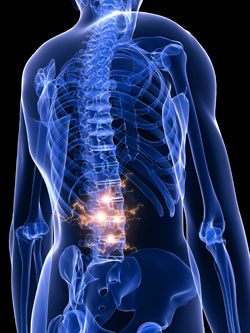 While the causes of back pain vary widely, some factors may increase a person's risk like obesity and even genetics. New research points to another potential risk factor for developing low back pain: having low pH levels within the spinal discs.
While the causes of back pain vary widely, some factors may increase a person's risk like obesity and even genetics. New research points to another potential risk factor for developing low back pain: having low pH levels within the spinal discs.
Low pH levels indicate that a fluid is acidic and oxygen-deprived. Although low pH levels can facilitate healthy functioning of certain processes within the body, like the pre-digestion performed by acidic saliva, when blood or other fluids dip to low pH levels, that could signal serious health problems. Previous research has linked low pH levels within the body to chronic illnesses. For instance, last year researchers from Japan found that people whose urine samples have low pH levels are more likely to suffer from chronic kidney disease. A recently developed hypothesis suggests low pH could also contribute to chronic pain in the lower back.1
It's well-known that low-back is tied to the degeneration of the discs between the vertebrae of the spine known as intervertebral discs. The pH within these discs is typically lower than other tissues, and would decrease in degenerated intervertebral discs.
A recent study sought to review the current evidence for the link between low pH in intervertebral discs and lower back pain. The authors identified seven studies focusing on the pathogenesis of low back pain caused by pH. Each article was analyzed with a focus on the mechanisms by which pH causes low back pain.
Within these 7 studies, the authors gave three explanations for the pathogenesis of low back pain in relation to low pH. First, low pH caused by lactate increases muscle tension, causing pain. Second, low pH stimulates the nerve roots, producing the sensation of pain. Finally, low pH changes the matrix metabolism, causing neuronal death and back pain. The authors concluded that further experimental studies are needed to test the hypothesis that low pH causes low back pain.
In a study published in an international medical journal last year, the same group of researchers proposed that low PH levels could produce an inflammatory response by the tiny bundles of nerve cells called the dorsal root ganglion. This inflammation may disrupt "the delicate nutrient balance within the nucleus [of the nerve cells], resulting in a vicious cycle and leading to chronic back pain."2
If low ph levels do indeed contribute to negative inflammatory responses, this could possibly be an additional mechanism underlying the success of chiropractic treatments for back pain. Studies suggest that chiropractic therapies positively influence the body's inflammatory responses. Of course, the proposed relationship between low pH and back pain will need further testing before we understand whether chiropractic affects pH levels within the spine.
Although these links have yet to be confirmed, the research could lead to new therapeutic approaches for low-back pain.
Written by Megan Churchwell and Marissa Luck
References
1. Liang C, Hao Li, Yao Y, et al. The relationship between low pH in intervertebral discs and low back pain: a systematic review. Archives of Medical Science 2012; 8(6): 952–956.
2. Liang C, Li H, Tao Y, et al. New hypothesis of chronic back pain: low pH promotes nerve ingrowth into damaged intervertebral disks. Acta Anaesthesiologica Scandinavica 2012. doi: 10.1111/j.1399-6576.2012.02670.x.
Watch the video below to learn more about how spinal degeneration causes back pain.